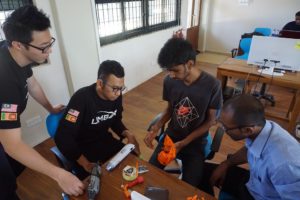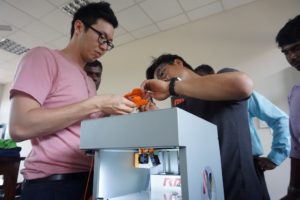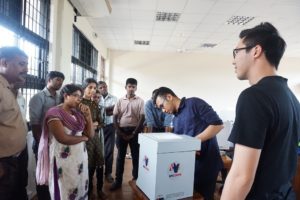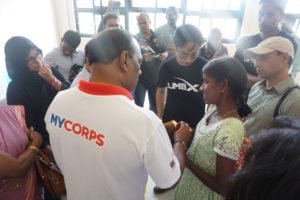Malaysian Doctor Leads LimbX Project Introducing 3D Printed Prosthetics to War-Ravaged Area of Sri Lanka
 Sri Lanka’s civil war ended in 2009, but it takes years, if not decades, to pick up the pieces after such a long conflict. Infrastructure needs to be rebuilt, landmines need to be removed, and many people are left with debilitating injuries. Those people can number in the hundreds of thousands, as Muhamad Hariz Hazwan Mohd Zarir (Hariz Hazwan) found out when he visited Sri Lanka as part of a humanitarian mission.
Sri Lanka’s civil war ended in 2009, but it takes years, if not decades, to pick up the pieces after such a long conflict. Infrastructure needs to be rebuilt, landmines need to be removed, and many people are left with debilitating injuries. Those people can number in the hundreds of thousands, as Muhamad Hariz Hazwan Mohd Zarir (Hariz Hazwan) found out when he visited Sri Lanka as part of a humanitarian mission.
Hariz is a doctor from Malaysia, and he traveled to Sri Lanka for two months as part of the MyCorps program. He was placed in the northern part of the country, where he learned that the war had left more than 160,000 people with missing limbs. The number continues to grow because of landmines that are still active. It was here that he began his project, LimbX.
“So, being there, I decided to dig deeper into the issues and tried to meet as many patients as possible,” Hariz told 3DPrint.com.
“I also made a point to see every single prosthetics care provider in the region and learnt about the issue – the available prosthetics are heavy, uncomfortable and non-functional. Most of the patients I met do not even use their upper limb prosthetics and even the associations for disabled people do not serve the upper limb amputees because nobody use the prosthetics. Another is I also met a patient who had been given a myoelectric (bionic hand) by an NGO 20 years ago but the wiring inside the hand has been broken off and now he’s left with a dead bionic hand for the past 2 years. And he couldnt fix it up because the NGO has left the place. So, I also learnt about the lack of local capacity to fix the prosthetics available.”
Two months is not a long time to overhaul such a large area of medical care in a country, but Hariz was determined to do it. He reached out to everyone he could think of with experience in prosthetics, including prosthetics expert and humanitarian technology leader Dr. Adam Arabian and LimbForge, formerly the Enable Community Foundation. Other expert institutions included the Jaffna Jaipur Centre for Disability Rehabilitation (JJCDR), the first prosthetic and rehab center in the area and among the first in the country, as well as mechanical engineering experts from the Faculty of Engineering at the University of Jaffna.
 He even flew in MyCRO, a Malaysian engineering research company that specializes in 3D printing, which sponsored a one-week training session on 3D printed prosthetics for 16 participants.
He even flew in MyCRO, a Malaysian engineering research company that specializes in 3D printing, which sponsored a one-week training session on 3D printed prosthetics for 16 participants.
“The participants are grouped in multidisciplinary settings – there are people from engineering backgrounds, prosthetists, physiotherapists and orthotists,” Hariz told us. “During this 1 week, participants are introduced to 3d printing and modeling as well as some basic prosthetics mechanics. We took a real case of a patient, let them work in a team and solve the case and everyone was giving an input. The engineers were helping with designing process while the clinicians were leading from clinical point of view. In the end of the program, they managed to solve case for real patient, who lost her hand in the war and another is a victim from demining group who lost both of his hands.”
After the workshop, the Faculty of Engineering at the University of Jaffna expressed interest in opening a prosthetics center, and proceeded from there to create the center, which has now been inaugurated by Datuk M. Saravanan, Deputy Minister of Youth and Sports Malaysia. The center, which will serve as both a clinic and prosthetic research center, has received grants from the governments of Malaysia and Sri Lanka, and is expected to become operational in January.
“The center is hopefully will be the focal point for the highest quality prosthetics care in the region as well as a way to help the system self-improve,” said Hariz. “Now we’re in the process of setting up the whole center, and building collaborations with collaborators around the world.”
The town of Kilinochchi, where the training program was held, has only existed for eight years and is now only one road long. According to Hariz, the 3D printing brought in for the program was the first 3D printer in that region of the country.
Hariz also pointed out that these clinics would not be relying solely on 3D printing technology; rather, he tells us, that is their starting point.
“We will be having older and conventional propylene technology soon in our pipeline so that we the ongoing researches there would be of benefit to the available system — and hopefully it will start a new area of research — the hybrid 3D printer/propylene technology system — and we could get the best of both worlds,” he told us.
Discuss this and other 3D printing topics at 3DPrintBoard.com or share your thoughts below.
[Images provided by Hariz Hazwan]
Subscribe to Our Email Newsletter
Stay up-to-date on all the latest news from the 3D printing industry and receive information and offers from third party vendors.
You May Also Like
Precision at the Microscale: UK Researchers Advance Medical Devices with BMF’s 3D Printing Tech
University of Nottingham researchers are using Boston Micro Fabrication‘s (BMF) 3D printing technology to develop medical devices that improve compatibility with human tissue. Funded by a UK grant, this project...
3D Printing Webinar and Event Roundup: April 21, 2024
It’s another busy week of webinars and events, starting with Hannover Messe in Germany and continuing with Metalcasting Congress, Chinaplas, TechBlick’s Innovation Festival, and more. Stratasys continues its advanced training...
3D Printing Webinar and Event Roundup: March 17, 2024
It’s another busy week of webinars and events, including SALMED 2024 and AM Forum in Berlin. Stratasys continues its in-person training and is offering two webinars, ASTM is holding a...
3D Printed Micro Antenna is 15% Smaller and 6X Lighter
Horizon Microtechnologies has achieved success in creating a high-frequency D-Band horn antenna through micro 3D printing. However, this achievement did not rely solely on 3D printing; it involved a combination...



































